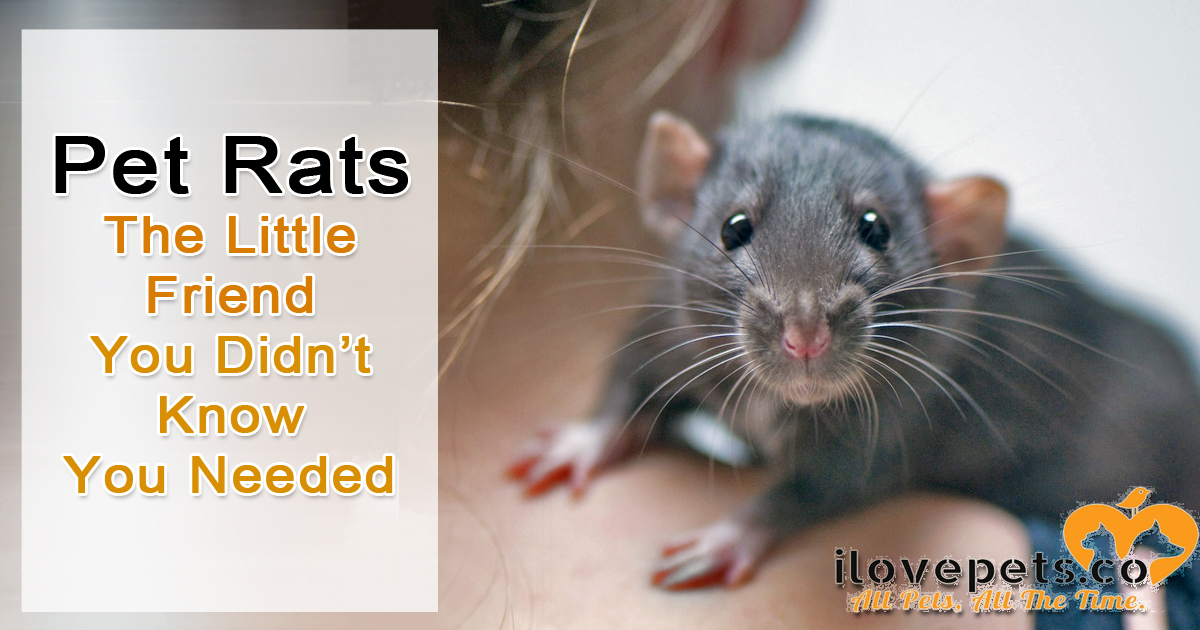
Pet rats are affectionate, intelligent animals that are remarkably easy to care for.
Understandably, many people still see them as scraggly survivors that run rampant in subway systems – but pet rats are so much more than that.
Give rats a chance and you’ll discover what you’ve been missing. Whether you’re unable to keep cats and dogs, or just love to try something new, you’ll be impressed by how sweet, clever and charming these animals can be.
Where To Get Your First Rat
You may see dozens of rats at your local pet store. Pet stores tend to be bad places to obtain most living things. Rats in pet stores do not tend to be socialized. Many are not separated by sex, so you can unexpectedly end up with a pregnant female. Pet store staff is rarely knowledgeable about proper care. A rat from a breeder won’t cost much more, and you’ll have a better chance at obtaining a healthy pet that is comfortable with being handled.
The best way to get a pet rat is from a breeder, shelter or rescue. Run a PetFinder search for “small and furry” to find adoptable rats near you. You can also Google “your town + rat breeder” to find local breeders, though many do not have websites. You can also get a referral from your vet, shelter or pet sitter. If you can’t find a local breeder, some breeders offer shipping.
Rats do well in pairs. They can become lonely and stressed out if they are alone. So, aim for getting two. They’ll have to be of the same sex to avoid unwanted pregnancies.
Rat Cage Essentials
The larger the cage, the more content your rat will be to spend most of the day inside it. Some cages come with multiple stories for your rat to explore.
You’ll need to line the cage with some soft bedding that will absorb urine and reduce odor. Choose carefully, as some bedding can irritate a rat’s delicate respiratory system. Bedding made from paper is popular with rat owners because it doesn’t create dust, and it’s often treated to absorb odor.
Rats can be litter trained, just like cats. You may want to get a litter box that fits inside the rat’s cage. The litter will need to be a different material than the bedding to help the rat distinguish it as a bathroom. Clay and clumping cat litters are toxic to rats. Some rat owners use paper towels or cat litter made from recycled newsprint.
Lastly, your rat will need cozy spots to burrow and sleep. You can find hammocks, tunnels and houses at the pet store, on Etsy or you can learn to make your own. It’s good to have extras so you’ll always have clean furnishings available.
Keeping Your Rat’s Cage Clean
As with all small animals, a rat’s cage can quickly become smelly if not cleaned often.
Take your rat out of the cage for at least an hour each day for playtime. Wipe down cage surfaces with a paper towel moistened with a mild white vinegar dilution. Remove any soiled bedding or litter, as well as any toys or furnishings that need to be cleaned.
You’ll need to do a full cleaning once a week, though you might be able to go longer between cleanings as you get better at daily spot cleaning.
What To Feed A Rat
One of the best things about having a rat is watching them eat. You’ll never tire of watching them hold food in those tiny pink hands as they munch away.
Lab blocks are nutritionally balanced pellets of food for rats. It’s uniform, so your rat gets all of the nutrients they need, instead of only eating their favorite bits as they would with a seed mix.
You can supplement your rat’s diet with fresh foods. Rats are omnivores. They need both meat and plants to stay healthy. Since rats can eat a wide variety of foods, you can easily supplement their diet with dinner leftovers and foods you have on-hand. Chicken, lettuce, rice and apples are just a few of the many foods pet rats love.
Avoid foods that are high in fat. Peanuts, dry uncooked beans and citrus fruits can cause health issues in rats.
Long Live The Rat
Sadly, a rat has a much shorter lifespan than most other pets, living just 2 to 3 years. Your rat will have the best chance of living a long life if you keep them at a healthy body weight and take them to the veterinarian for regular wellness checkups.
Rats tend to suffer from two major health issues: tumors and respiratory infections. A well-ventilated living-space and a healthy diet can lower your rat’s chances of getting sick.
When you first bring your rat home, they’re likely to have a mild case of the sniffles. This is due to them getting used to a new environment, and should clear up quickly. See a vet for any persistent sneezing, coughing or discharge.
What To Do With Your Pet Rat
You might be surprised at just how much a rat can do. They’re capable of so much more than hanging out in a cage all day.
Rats respond well to positive reinforcement training. You can even clicker train your rat to do tricks. Rats can fetch, jump through hoops, and navigate a tiny obstacle course.
You can make or buy an itty-bitty harness and leash for your pet rat and take them out in public.
When well-socialized, rats are very affectionate and love to be around people. My friend Abby, who helped with this post, writes about how she’s raising therapy rats over at Healing Whiskers.
While many people are afraid of rats, you can help educate others about them by raising yours to be a shining example of a smart, sweet, cuddly pet. With love, treats and attention, your rat can change the world!
LEAVE A COMMENT below to share your thoughts and experiences. We would love to hear from you!
Don’t forget to SHARE this article on your favorite social media outlets:







[…] of a squirrel, consider a rat – they’re extremely affectionate and intelligent, and there’s a surprising number […]
[…] room or resources for two, as long as you are able to spend at few hours a day playing with them. Rats thrive in same sex pairs. Some people neuter their male rats so they can be paired with a female without causing unwanted […]
[…] can be cuddly, playful and sociable. However, they’re not as affectionate as a pet rat. You may also be interested in learning about the differences between hamsters and gerbils to see […]
[…] are different than other small animals like rats and hamsters. They need to be spayed or neutered before they reach puberty to prevent aggression. A […]